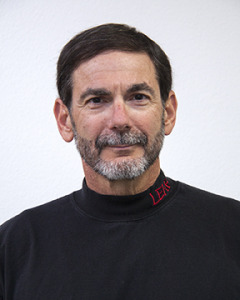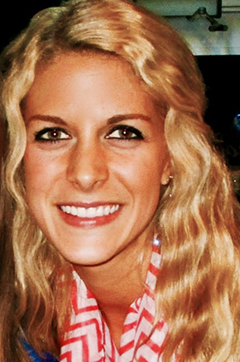Posted 8:40 a.m. Tuesday, May 19, 2015

A UW-L study finds that some participants in a very hot yoga class — Bikram yoga — had core temperatures at or near the point where heat-related illnesses can occur.
 John Porcari[/caption]
UW-L alumna Emily Quandt, a former clinical exercise physiology student, took on the study as her UW-L graduate thesis project with adviser John Porcari, UW-L professor of exercise and sport science, in spring 2014. The results were published in April.
“I’m all for exercise, but also doing exercise in a safe environment,” says Quandt. “It was questionable to me whether it was safe in Bikram classes when I heard how the class was run.”
In the hot conditions, practitioners follow a specific series of 26 poses two times throughout the 90-minute class. Hydration is usually left up to the discretion of participants, but people who don’t drink are often viewed as being more mentally and physically strong.
“People really seem to enjoy it. They feel like they really accomplish something,” says Porcari. “However, I don’t think they appreciate the potential concerns of being that hot.”
To find out if there were concerns, UW-L researchers visited a Bikram Yoga class in a studio near Chicago in spring 2014. They had participants swallow a sensor that monitored core temperatures. Subjects wore a heart rate monitor throughout the class.
Researchers found that participant’s core temperature on average rose to 103.2 degrees F and their heart rates averaged 75 percent of the predicted maximal values.
[caption id="attachment_41191" align="alignright" width="240"]
John Porcari[/caption]
UW-L alumna Emily Quandt, a former clinical exercise physiology student, took on the study as her UW-L graduate thesis project with adviser John Porcari, UW-L professor of exercise and sport science, in spring 2014. The results were published in April.
“I’m all for exercise, but also doing exercise in a safe environment,” says Quandt. “It was questionable to me whether it was safe in Bikram classes when I heard how the class was run.”
In the hot conditions, practitioners follow a specific series of 26 poses two times throughout the 90-minute class. Hydration is usually left up to the discretion of participants, but people who don’t drink are often viewed as being more mentally and physically strong.
“People really seem to enjoy it. They feel like they really accomplish something,” says Porcari. “However, I don’t think they appreciate the potential concerns of being that hot.”
To find out if there were concerns, UW-L researchers visited a Bikram Yoga class in a studio near Chicago in spring 2014. They had participants swallow a sensor that monitored core temperatures. Subjects wore a heart rate monitor throughout the class.
Researchers found that participant’s core temperature on average rose to 103.2 degrees F and their heart rates averaged 75 percent of the predicted maximal values.
[caption id="attachment_41191" align="alignright" width="240"] Emily Quandt[/caption]
Seven of the participants had a core temperature that reached more than 103 degrees, and one participant reached 104.1 degrees F.
At 104 degrees F, heat-related illnesses such as heat stroke, headaches, vomiting and seizures can occur, says Porcari.
Porcari explains that normal body temperature is 98.6 degrees F. Typically, when people exercise, body heat increases to about 100 or 101. Then the body starts to sweat to get rid of the heat. But if people are exercising in environment that is hotter than their body temperature, the heat doesn’t dissipate as easily.
The results point to the need for instructors and the participants to be able to recognize signs and symptoms of heat-related illness such as dizziness, light headedness or nauseousness. Also, they should hydrate frequently before, during and after hot classes.
Porcari explains the results don’t point to concerns for a typical hot yoga class where room temperatures are typically between about 90-95 degrees F. In a past UW-L study of a hot yoga class, UW-L researchers saw no concerns with the safety of participant’s core temperatures as the room was kept around 93 degrees and the instructor encouraged participants to hydrate regularly.
UW-L collaborates with ACE often
UW-L has developed a niche for conducting practical research that answers questions the general public might have about new pieces of exercise equipment on the market, training regiments, infomercial promises and more.
This study was funded through a grant from the American Council on Exercise, the world’s leading provider of personal trainer certifications, exercise information, workouts and more. UW-L researchers typically do about five projects each year through ACE grants. Porcari estimates they’ve done nearly 500 projects for ACE on these topics in the last 25 years. Many of the projects also become thesis projects for UW-L graduate students in the clinical exercise physiology program.
Read more about the study.
Emily Quandt[/caption]
Seven of the participants had a core temperature that reached more than 103 degrees, and one participant reached 104.1 degrees F.
At 104 degrees F, heat-related illnesses such as heat stroke, headaches, vomiting and seizures can occur, says Porcari.
Porcari explains that normal body temperature is 98.6 degrees F. Typically, when people exercise, body heat increases to about 100 or 101. Then the body starts to sweat to get rid of the heat. But if people are exercising in environment that is hotter than their body temperature, the heat doesn’t dissipate as easily.
The results point to the need for instructors and the participants to be able to recognize signs and symptoms of heat-related illness such as dizziness, light headedness or nauseousness. Also, they should hydrate frequently before, during and after hot classes.
Porcari explains the results don’t point to concerns for a typical hot yoga class where room temperatures are typically between about 90-95 degrees F. In a past UW-L study of a hot yoga class, UW-L researchers saw no concerns with the safety of participant’s core temperatures as the room was kept around 93 degrees and the instructor encouraged participants to hydrate regularly.
UW-L collaborates with ACE often
UW-L has developed a niche for conducting practical research that answers questions the general public might have about new pieces of exercise equipment on the market, training regiments, infomercial promises and more.
This study was funded through a grant from the American Council on Exercise, the world’s leading provider of personal trainer certifications, exercise information, workouts and more. UW-L researchers typically do about five projects each year through ACE grants. Porcari estimates they’ve done nearly 500 projects for ACE on these topics in the last 25 years. Many of the projects also become thesis projects for UW-L graduate students in the clinical exercise physiology program.
Read more about the study.